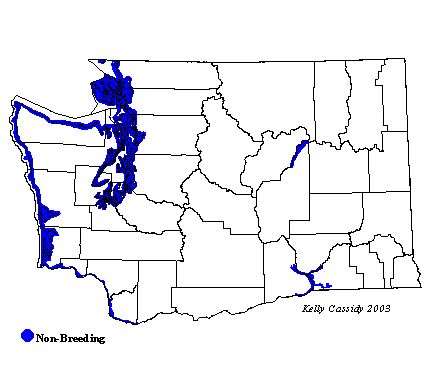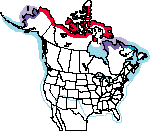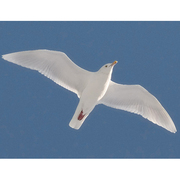Glaucous Gull
The Washington representatives of this family can be split into two groups, or subfamilies. The adaptable gulls are the most familiar. Sociable in all seasons, they are mainly coastal, but a number of species also nest inland. Many—but not all—are found around people. Gulls have highly variable foraging techniques and diets. Terns forage in flight, swooping to catch fish or insects. They dive headfirst into the water for fish. Although they are likely to be near water, they spend less time swimming than gulls.
General Description
An inhabitant of the far north, the Glaucous Gull is a large, pale gull with a large bill. The adult appears very white. Its back and wings are light gray, and the wingtips are white, with no black on the wing. The tail is white. The legs are pink, and the eyes are yellow. The bill is yellow with a red spot. In the non-breeding season, the adult's head is streaked with brown. Birds in breeding plumage have pure white heads and fleshy yellow eye-rings. The Glaucous Gull may be confused with the Glaucous-winged Gull, with which it hybridizes. Like most of the large gulls, this is a '4-year gull,' meaning that it takes 4 years to reach adult plumage, with a different sub-adult plumage each year. Juveniles are mostly white with buff markings. The first-year plumage is distinguished from that of a Glaucous-winged Gull by the distinctly bi-colored bill with a dark tip and a flesh-pink base. This plumage is the one most commonly seen in Washington.
Habitat
The Glaucous Gull is the only large gull common in the high Arctic. It inhabits cold, coastal bays, estuaries, and offshore areas. In winter, Glaucous Gulls have been found on large inland lakes. Nesting habitat is mainly cliff ledges, islands, and beaches. Foraging habitat includes garbage dumps, fish-processing plants, harbors, mud flats, sewage lagoons, flooded fields, and fish-spawning areas.
Behavior
The Glaucous Gull usually associates with flocks of other roosting and feeding gulls such as Glaucous-winged and Herring Gulls. A predator and a scavenger, the Glaucous Gull will steal food from other birds. It forages while flying, walking, or swimming. In flight, it picks items off the surface of the water and may catch smaller birds.
Diet
Glaucous Gulls eat fish and other aquatic creatures, as well as insects, birds, eggs, berries, carrion, and garbage.
Nesting
Pairs nest in colonies or alone on cliff tops, flat, rocky ground, ice, or snow. Both adults help build the nest, which is a mound of vegetation and miscellaneous debris, depressed in the center. Both incubate the 3 eggs for about 4 weeks. Both parents feed the downy chicks for close to 2 months. The young leave the nest on foot a few days after hatching, and they stay close to the nest until their first flight at 45-50 days, soon after which they become independent.
Migration Status
Some, mostly younger, birds leave the Arctic and move south for the winter, heading down either coast of North America, or to the Great Lakes. Many remain as far north as there is open water through the winter.
Conservation Status
Glaucous Gulls are widespread and common in the far north where they are protected from human activities due to the remoteness. High Arctic habitats are slow to rebound from degradation, and these areas should be protected to maintain the population at its current healthy level. Populations in the eastern Bering Sea hybridize with Glaucous-winged Gulls.
When and Where to Find in Washington
The Glaucous Gull is a rare winter visitor in all lowland regions of Washington, found in both fresh and salt water and along sandy and rocky shorelines. West of the Cascades, you can see Glaucous Gulls from mid-November to mid-May. The Elwha River (Clallam County) and the Nisqually Delta (Pierce County) are areas with large congregations of gulls. Look carefully for Glaucous Gulls in the flocks. Between mid-November and March, they can be found east of the Cascades on Banks Lake in Grand Coulee (Grant County). Usually, single birds are found with large flocks of other gulls, and most are first- or second-year birds.
 Abundance
Abundance
| Ecoregion | Jan | Feb | Mar | Apr | May | Jun | Jul | Aug | Sep | Oct | Nov | Dec |
|---|---|---|---|---|---|---|---|---|---|---|---|---|
| Oceanic | R | R | R | R | R | R | R | |||||
| Pacific Northwest Coast | R | R | R | R | R | R | R | R | R | |||
| Puget Trough | R | R | R | R | R | |||||||
| North Cascades | ||||||||||||
| West Cascades | R | R | R | R | ||||||||
| East Cascades | ||||||||||||
| Okanogan | ||||||||||||
| Canadian Rockies | ||||||||||||
| Blue Mountains | ||||||||||||
| Columbia Plateau | R | R | R | R |
Washington Range Map

North American Range Map


Family Members
 Laughing GullLarus atricilla
Laughing GullLarus atricilla Franklin's GullLarus pipixcan
Franklin's GullLarus pipixcan Little GullLarus minutus
Little GullLarus minutus Black-headed GullLarus ridibundus
Black-headed GullLarus ridibundus Bonaparte's GullLarus philadelphia
Bonaparte's GullLarus philadelphia Heermann's GullLarus heermanni
Heermann's GullLarus heermanni Black-tailed GullLarus crassirostris
Black-tailed GullLarus crassirostris Short-billed GullLarus canus
Short-billed GullLarus canus Ring-billed GullLarus delawarensis
Ring-billed GullLarus delawarensis California GullLarus californicus
California GullLarus californicus Herring GullLarus argentatus
Herring GullLarus argentatus Thayer's GullLarus thayeri
Thayer's GullLarus thayeri Iceland GullLarus glaucoides
Iceland GullLarus glaucoides Lesser Black-backed GullLarus fuscus
Lesser Black-backed GullLarus fuscus Slaty-backed GullLarus schistisagus
Slaty-backed GullLarus schistisagus Western GullLarus occidentalis
Western GullLarus occidentalis Glaucous-winged GullLarus glaucescens
Glaucous-winged GullLarus glaucescens Glaucous GullLarus hyperboreus
Glaucous GullLarus hyperboreus Great Black-backed GullLarus marinus
Great Black-backed GullLarus marinus Sabine's GullXema sabini
Sabine's GullXema sabini Black-legged KittiwakeRissa tridactyla
Black-legged KittiwakeRissa tridactyla Red-legged KittiwakeRissa brevirostris
Red-legged KittiwakeRissa brevirostris Ross's GullRhodostethia rosea
Ross's GullRhodostethia rosea Ivory GullPagophila eburnea
Ivory GullPagophila eburnea Least TernSternula antillarum
Least TernSternula antillarum Caspian TernHydroprogne caspia
Caspian TernHydroprogne caspia Black TernChlidonias niger
Black TernChlidonias niger Common TernSterna hirundo
Common TernSterna hirundo Arctic TernSterna paradisaea
Arctic TernSterna paradisaea Forster's TernSterna forsteri
Forster's TernSterna forsteri Elegant TernThalasseus elegans
Elegant TernThalasseus elegans

